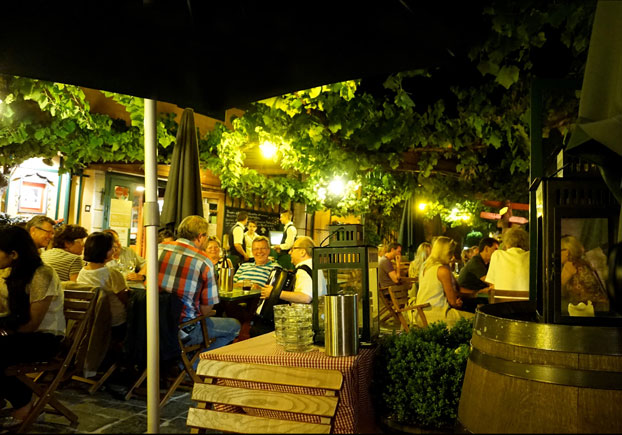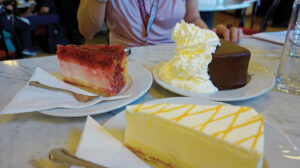At the Grand Hotel in Vienna, I am amazed to see an explosion of veiled women, with large shopping bags of designer goodies, children and maids in tow. Of course they are all accompanied by Arab men. Perhaps there is a conference on, I think. But later Isabella, Team Manager Media Management, Vienna Tourist Board, tells me that the Arab visitors like to stay at the Grand Hotel because they allow them to bring their own cooks.


A good point to note for Indians, particularly vegetarians, especially Jains who are often miserable while travelling
overseas and find it difficult to explain to restaurateurs that even in vegetarian food there can be restrictions.
Anyway, I have none, so I set out in Vienna, a gourmet delight, to sample all kinds of food.
Coffee house culture
First and foremost, in this Austrian city, you have to soak in the coffee house culture, discreetly and delicately moving aside the heaps of  double cream adorning their heavenly pastries. We head for Café Central which has a pride of place in the city’s history as the who’s who of Vienna’s intellectuals were regular patrons here, one of them being Sigmund Freud. Apparently Adolf Hitler also loved its delicacies! With a lot of chess playing happening here, till 1938 it was called the ‘Chess School.’ At the end of World War II it was closed and in1975, it was renovated and opened for business. Today it is a buzzing tourist spot, and proud of its literary history, has a corner where, sipping your cup of
double cream adorning their heavenly pastries. We head for Café Central which has a pride of place in the city’s history as the who’s who of Vienna’s intellectuals were regular patrons here, one of them being Sigmund Freud. Apparently Adolf Hitler also loved its delicacies! With a lot of chess playing happening here, till 1938 it was called the ‘Chess School.’ At the end of World War II it was closed and in1975, it was renovated and opened for business. Today it is a buzzing tourist spot, and proud of its literary history, has a corner where, sipping your cup of

coffee and tucking in its delicious cakes and pastries, you can leaf through newspapers and journals on a lazy afternoon, and watch the world go by.
I opt for the Melange, which is just like the Italian cappuccino, but with more coffee than milk, my guide Ilse points out. She quickly orders lemon, raspberry and chocolate cakes and we have a tough time putting aside the overwhelming cream topping. As I watch a little boy, accompanied by his father, struggle to decide on his pastry, I learn that some of the tables at this iconic coffee house are reserved for regulars, and others are not allowed to occupy them. Regular patronage is respected here.
City of sausages and schnitzels

A few hours in Vienna will tell you this is a city of sausages! They occupy the pride of place on most menus, and you can find sausage stands all around the city. When the Viennese have little or no time for lunch they go to the sausage stands, grab a couple of sausages with some bread, and that is lunch. None of our elaborate thalis for them. The Viennese have a lot of spaghetti, other pasta and the young just love to guzzle pizza! But in Vienna the pride of place has to go to their trademark schnitzels.
The world-famous Wiener (Viennese) Schnitzel is a tender flat veal cutlet, coated in flour, egg and breadcrumbs, and pan-fried in butter and oil to a perfect golden brown. It typically comes with potato salad, but is also served with boiled potatoes or a side salad. Just like Indians, the Viennese too have a passion for deep-fried dishes, and apart from the schnitzel which is deep fried, other staples too are tossed in breadcrumbs and fried … chicken pieces (Backhendl), liver, fish, and a variety of vegetables.
A favourite debate topic with the locals is which city restaurant or pub makes the best schnitzel. They also agree that there are plenty of candidates to choose from!
Most visitors order cakes as these are delicious and melt in the mouth, but schnitzels are also available. And neither the cakes nor the coffee is too expensive, costing between 3–4 euros.
While lunch is on the run, what do the Viennese have for breakfast? Not surprisingly — the variety of breads here are to die for — I learn that most people have for breakfast a traditional bread or a roll with cheese, ham, sausage or jam.
What about eggs? “Oh no, eggs are not so traditional; that’s an influence from the English or American breakfast. Even those who go in for an egg would take it boiled,” says Ilse.
Variety of beers
As I’ve landed in Vienna on a record-making hot summer day, with the mercury sizzling around 35–37 deg C, in the afternoons a chilled beer is the obvious choice. Austria has a wide variety of beers, with Stigl and Gösser being popular brands. Ilse says that beer has been found in Vienna and other Austrian cities since 1492. “In the monasteries, traditionally the monks brewed their own beer, which was not only a drink but a substitute for food to strengthen them. Particularly before Easter and the 40 days of fasting. During Lent the monks were not allowed to eat, but they were allowed to have two litres of beer every day, and it was strong beer!” Lent beer is stronger than normal beer, she adds. The Viennese love their wines too and there are several vineyards and wineries in this city. But they are not great whiskey drinkers; if a stronger spirits is desired, most of the time schnapps is the drink of choice.
What about Raka, I ask, recalling the timely little helping offered to me once by a monk on a freezing winter day in Greece. “No we don’t take Raka here,” smiles Ilse, adding, “but it reminds us of holidays in Greece! We also like drinking vodka, but not as much as the Russians!”
But beer is a hot draw and men with beer bellies are referred to as Gösser Muskel; “it’s a humorous Austrian expression for a beer belly,” she adds.
History of Viennese Cuisine
Vienna is probably the only city in the world which has its name on a particular style of cooking. This has evolved by the blending of the best culinary traditions from Bohemia, Austria, Hungary, Italy and the Balkans, to make some unusual dishes. As Vienna was at the heart of the Austro-Hungarian monarchy for centuries, it imbibed the culinary traditions and influences from all these countries. “The capital’s location — close to Hungary, Bohemia and Moravia — and the presence of exceptionally gifted female cooks from all over the empire in well-to-do Viennese households saw the city’s cuisine take on a distinctly Eastern European flavour,” says Isabella.
Hungary contributed goulash, as well as the strudel, which it had in turn borrowed from Turkey. Bohemia, now part of the Czech Republic, contributed many of the city’s pastries (known as Mehlspeisen). The secret behind the calories-stuffed sweet dishes such as pancakes and apricot dumplings, often served as a main course, is the Bohemian influence! The jewel in the Viennese culinary crown, the Wiener Schnitzel, is rumoured to have reached the Austrian capital from Istanbul via Venice and Milan!
Delicious soups
Viennese cuisine is also famous for its clear soups, which are traditionally served as starters. I try for lunch a classic Viennese beef soup garnished with green vegetables, chives and parsley and it proves to be a delicacy, the taste of which will linger for a long time. The broth of this soup is made from beef, bone and vegetable stock that is simmered for hours, after which various extras are added. This soup can also be had with semolina or liver dumplings. Dumplings are a big draw in Vienna.
I next try a grilled snapper, which is crisp on the outside but oh-so-tender and fresh on the inside. A smoked sausage bought from a street stall, stuffed in freshly baked bread, is another delicacy that is highly recommended. Also, don’t miss the famous Viennese rolls stuffed with delicious jams … I tried peach and wasn’t disappointed. An occasional pizza or pasta in any Viennese restaurant won’t disappoint you. This is apparently a city which knows its food!
The Viennese have a sweet tooth and the sweet delicacies in this city will quadruple your guilt complex and send you sprinting to the gym! Many hotels have their trademark delicacies and the more upmarket ones keep a sweet souvenir in your room to take away.
Mine had a tantalising box carrying the delicious cake that is branded as the original Grand Guglhupf, and the hotel claims that Emperor Franz Joseph loved it just the way it was made — from a secret recipe — from the best ingredients without artificial flavours or additives. The difference was deciphered by the taste buds!
But the delicacy to die for is said to be the original Sacher Torte, the most famous cake in Vienna, as the rest of Austria. According to literature from Vienna Tourism, this fluffy chocolate cake made with apricot jam and chocolate glaze is prepared at the legendary Hotel Sacher, behind the Vienna State Opera, again through a secret recipe dating back to 1832! This cake was invented by Franz Sacher, an apprentice chef employed by the royal household. More than 360,000 of these cakes are made by hand each year. A third are eaten at the hotel itself, a third sold elsewhere and the remainder sent to cake lovers all over the world. Well, I missed it, but it’s a good enough excuse to return to this lovely European city, which is much kinder on your pocket than the neighbouring Swiss cities.
Pictures by Rasheeda Bhagat





